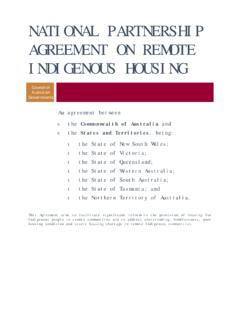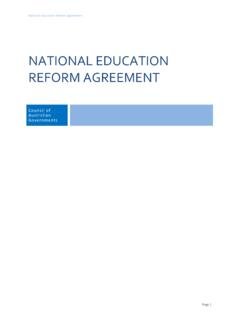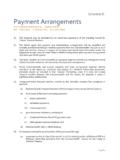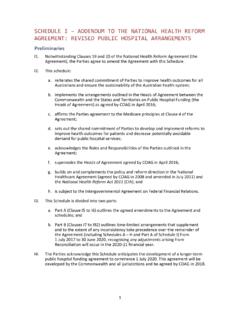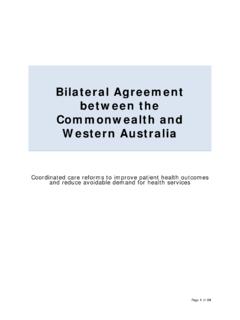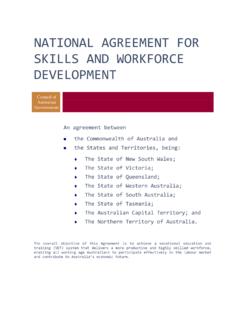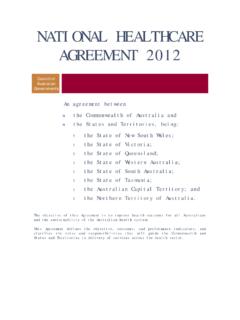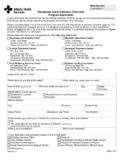Transcription of National Indigenous Reform Agreement Nov 12
1 National Indigenous Reform Agreement National Indigenous . Reform Agreement . (CLOSING THE GAP). Council of Australian Governments An Agreement between n the Commonwealth of Australia and n the States and Territories, being: t the State of New South Wales;. t the State of Victoria;. t the State of Queensland;. t the State of Western Australia;. t the State of South Australia;. t the State of Tasmania;. t the Australian Capital territory ; and t the Northern territory of Australia This Agreement implements intergovernmental reforms to close the gap in Indigenous disadvantage. National Indigenous Reform Agreement National Indigenous Reform Agreement National Indigenous Reform Agreement INTERGOVERNMENTAL Agreement .
2 ON FEDERAL FINANCIAL RELATIONS. PRELIMINARIES. 1. This Agreement is created subject to the provisions of the Intergovernmental Agreement on Federal Financial Relations and should be read in conjunction with that Agreement and subsidiary schedules. In particular, the schedules include direction in respect of performance reporting and payment arrangements. 2. The Parties are committed to addressing the issue of social inclusion. That commitment is embodied in the objectives and outcomes of this Agreement . However, the Parties have also agreed other objectives and outcomes which the Parties will pursue through the broadest possible spectrum of government action.
3 Consequently, this Agreement will be implemented consistently with the objectives and outcomes of all National Agreements and National Partnerships entered into by the Parties. 3. In December 2007, the Council of Australian Governments (COAG) agreed to a partnership between all levels of government to work with Indigenous communities to achieve the target of Closing the Gap in Indigenous disadvantage. 4. This National Indigenous Reform Agreement has been established to frame the task of Closing the Gap in Indigenous disadvantage. It sets out the objectives, outcomes, outputs, performance indicators and performance benchmarks agreed by COAG.
4 It also provides links to those National Agreements and National Partnership agreements across COAG. which include elements aimed at Closing the Gap in Indigenous disadvantage. 5. The National Integrated Strategy for Closing the Gap in Indigenous Disadvantage can be found at Schedule A. The foundation of the Closing the Gap Strategy is the identification of and commitment to targets addressing Indigenous disadvantage, and associated building blocks areas for action. This Strategy acknowledges the importance of Indigenous culture, and engagement and positive relationships with Indigenous Australians. It discusses the contribution of the current COAG Reform initiatives to meeting the targets, the frameworks for accountability and performance reporting, and also signals areas for future work.
5 6. The National Indigenous Reform Agreement , like other National Agreements, is a living document subject to enhancement over time to reflect additions and changes to existing and new National Agreements and National Partnership agreements. As COAG agrees to additional reforms to Close the Gap in Indigenous disadvantage, these will be reflected in this Agreement . Page 3. National Indigenous Reform Agreement COAG framework 7. Despite the concerted efforts of successive Commonwealth, State and territory governments to address Indigenous disadvantage, there have been only modest improvements in outcomes in some areas such as education and health, with other areas either remaining static or worsening.
6 Even in those areas where there have been improvements, the outcomes for Indigenous Australians remain far short of the outcomes for non- Indigenous Australians. To Close the Gap in Indigenous disadvantage, COAG has committed to making significant reforms in order to address six specific targets (see Objectives). 8. COAG recognises that overcoming Indigenous disadvantage will require a long-term, generational commitment that sees major effort directed across a range of strategic platforms or Building Blocks' which support the reforms aimed at Closing the Gap against the six specific targets. The Building Blocks endorsed by COAG are: (a) Early Childhood.
7 (b) Schooling;. (c) Health;. (d) Economic Participation;. (e) Healthy Homes;. (f) Safe Communities; and (g) Governance and Leadership. 9. COAG recognises that strategies aimed at achieving improvements in any particular area will not work in isolation the building blocks must fit together through the integration of policy ideas and an agreed approach to their implementation. Further information on the Building Blocks is at Box 1. COAG commitments 10. In the context of the Building Blocks framework, COAG has commenced the task of addressing Indigenous disadvantage across each of the strategic platforms. Some National Partnership agreements have an Indigenous specific focus, addressing one or more of the building blocks: (a) Remote Indigenous Service Delivery.
8 (b) Indigenous Economic Participation;. (c) Indigenous Early Childhood Development;. (d) Indigenous Health;. (e) Remote Indigenous Housing; and (f) Remote Indigenous Public Internet Access. 11. In 2008, COAG requested the development of an urban and regional strategy to coordinate the delivery of services to Indigenous Australians. The National Urban and Regional Service Delivery Strategy, at Schedule B is a plan for action developed by the Page 4. National Indigenous Reform Agreement Commonwealth, State and territory Governments. The Strategy recognises that without achieving significant gains in urban and regional locations, it will not be possible to Close the Gap nationally on any of the COAG targets.
9 The strategy requires jurisdictions to leverage Indigenous specific and mainstream funding agreed by COAG, and other existing resources, to improve Indigenous Australians' outcomes in urban and regional areas. 12. Moreover, an important feature of the COAG framework is the focus on achievement of outcomes including Indigenous outcomes through the renegotiated National Agreements, and mainstream National Partnership agreements. These agreements aim to improve outcomes for a wide range of Australians, including Indigenous Australians. Some National Partnerships (such as Improving Teacher Quality) include Indigenous specific outcomes.
10 Further information on the National Agreements and National Partnership agreements can be found at the Policy and Reform Directions section and at Schedule C. 13. A key feature of the National Agreements will be enhanced reporting against specified indicators and COAG has agreed to reporting arrangements which will see many indicators disaggregated by Indigenous and non- Indigenous status. This will facilitate close examination by COAG and the public of progress towards Closing the Gap and will complement other reporting mechanisms, such as the COAG-sponsored Overcoming Indigenous Disadvantage Key Indicators Report. 14. The objectives, outcomes, outputs, performance indicators, and performance benchmarks noted in this and other Agreements will be used by the COAG Reform Council to assess progress in Closing the Gap in Indigenous disadvantage.
